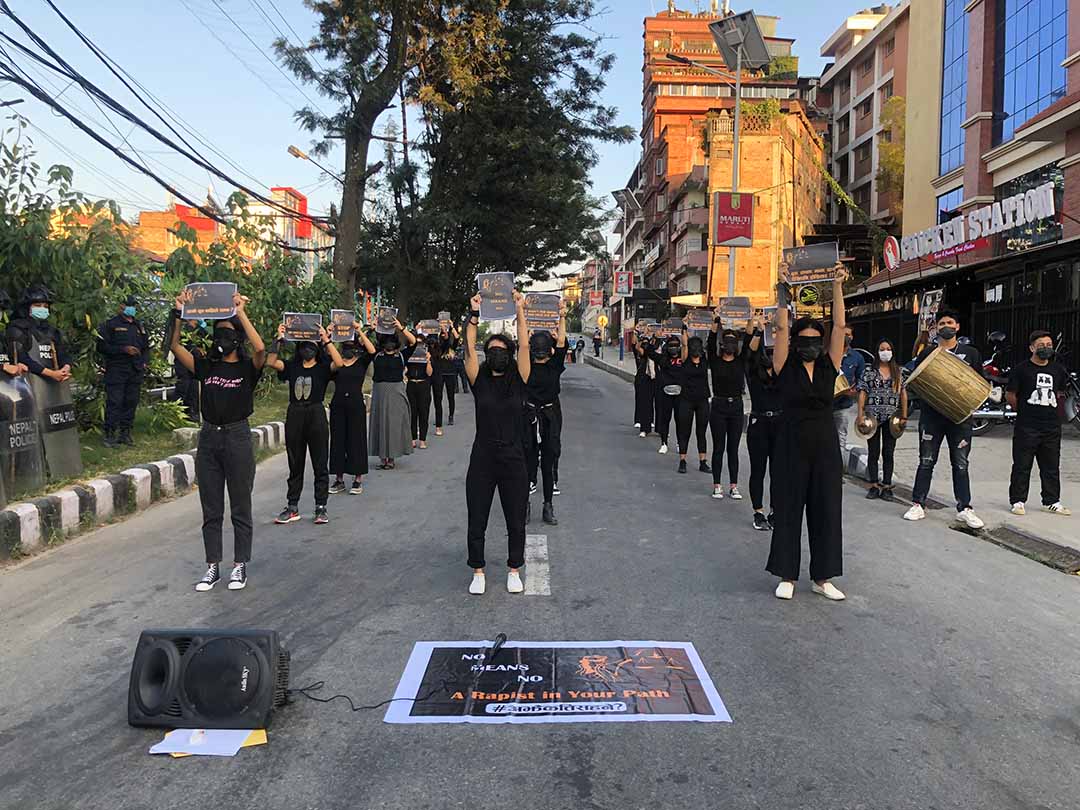Photo courtesy : Ajhai Kati Sahane

Photo courtesy : Ajhai Kati Sahane
Author: Aakriti Ghimire
Justice for violence against women is a far cry in Nepal.
Women are violated every day – in their own homes, schools and communities – at hands of family members and strangers. A large number of women are victims of domestic abuse and sexual violence, which was further exacerbated during the pandemic.
Data from the Nepal Police shows 2,144 cases of rape and 687 cases of attempted rape were reported in the fiscal year 2019-20 an increase from 1,480 cases of rape and 727 cases of attempted rape from the fiscal year 2017-18.
According to reports, 48 per cent of Nepali women have experienced some form of violence at some point in their lives. 15 per cent of them have been victims of sexual violence. During the pandemic, cases of intimate partner violence, and online harassment increased in staggering numbers.
Despite existing laws against GBV, they are rarely implemented. Only a countable few incidents reported moved to prosecution. The majority of cases are mediated by authorities themselves despite rules prohibiting out-of-court settlements. A culture of silencing and stigmatizing limits the survivors from accessing justice.
Women’s rights activists and advocates have long demanded justice for violence against women through various social justice movements – many in-person, some virtual. These movements have always been non-violent and based on the fundamentals of human rights.
Nonviolent social justice movements demanding justice for atrocities inflicted upon women can be traced back to the 1980s, when mass rallies were organized in Kathmandu protesting triple rape and murder of Namita Bhandari, Sunita Bhandari, and Neera Parajuli.
The case remains unsolved till date, given the suspicions of involvement of royal family members and influential people.
Despite sheer frustration at the ignorance of the government towards issues such as violence against women, activists believe their movements should align with the fundamentals of human rights. In recent years, various creative forms are also devised to raise voices against the culture of impunity in Nepal.
In the past five years alone, hundreds of women have taken to the streets to protest against the ignorance of the government to deal with GBV cases. Oftentimes, after witnessing the negligence of the police and authorities in dealing with such cases, the public has retaliated.
In the gang-rape case in Landmark Hotel, Kathmandu on January 25, 2018, the police in charge refused to register the complaint and told the victim to settle the issue with her rapists.
Following the case, a social media movement on #RageAgainstRape was initiated that spread like wildfire. Activists in the movement aimed at creating pressure on the Nepali government to safeguard rape victims and create an environment where potential perpetrators are deterred.
A few months later, another rape case shook the entire nation. On July 26 2018, Nirmala Panta, a 13-year-old student in far-western Nepal, was raped and killed.
The entire nation came to the streets demanding justice for Nirmala. Symbolic protests by beating plates were organized. Sit-in protests in open tents in front of District Headquarters at Kanchanpur were held. Posters reading “Justice delayed is justice denied” hung all across the capital. Slogans chanted in front of Singha Durbar. A peaceful civic rally was held in Kathmandu in December 2018.

In light of the increasing cases of GBV and frustration at the nation’s indifference towards Nirmala’s case, amidst the pandemic at the end of 2020, flash mobs organized in Kathmandu Dang, Hetauda, Nawalpur, Sindhuli, Biratnagar, Mahendranagar, Dhangadi and Birtamod.
Three months later, another rape case of Bhagirathi Bhatta, a 17-year-old from Baitadi, pushed more than 500 protestors out on the street with placards and loud slogans.
A mock funeral of a young girl clad in white was organized as a symbolic protest. Women dressed all in black with blindfolds over their eyes. Speeches and poems recited.

Over the years, chants echoed the streets of Nepal – ‘balatkaari hos ta,’ ‘my vagina will vote you out,’ ‘hum ab Sita nahi banbau,’ – as the demonstrators demanded justice for women whose bodies and lives have been violated by the patriarchal state.
Adding on to those movements often fought for upper-caste women, on October 8 2021, another social movement advocating for marginalized Muslim women sent shockwaves across the nation.
This time, 11 women from marginalized communities – Muslims, Dalits and Madhesis – from Banke walked from Nepalgunj to Kathmandu, covering a distance of approximately 500 kilometres on foot, demanding justice for the disappearance and murder of two women, Nirmala Kurmi and Nakunni Dhobi.
They organised two sit-in protests, and the second one went on for 42 days when the government finally agreed to have conversations with protestors.
These nonviolent protests over the years, however, aren’t well received. They are always met with resistance, either from the public or the government, and many times from both.
They face various challenges at steps all along the way. At home, many are discouraged to go and protest. They continue to receive threats from the accused perpetrators even today.
Nirmala Panta, Nirmala Kurmi and Nakunni Dhobi’s cases were consequences of the state’s political negligence. In the 2018 movement organized for Nirmala Panta, the state attempted at diverting the attention of the public proclaiming “a dawn of a new era” in Nepal, rolled out by then KP Oli government.
In the 2021 movement for Nirmala Kurmi and Nakunni Dhobi, the police fabricated cases against movement leaders to suppress the movement.
The government and police authorities have attempted to discredit such social movements time and again by either arresting them at dinner times, assassinating their characters or destroying evidence, according to protestors.
Women leading such movements are often labelled ‘dollarbadis,’ ‘nazi feminists’ and ‘deshdrohi’ for merely demanding their rights and seeking justice.
In response to such movements, pages such as ‘Balatkari Sangathan’ (rapist association) also surfaced that highlight the insidious patriarchal mindset of the public.
Today, the protestors from Banke still live at risk in their homes. They need police security as they move around their city for the threats they receive from the accused.
From death threats and rape threats to the police officials assassinating characters of protestors, the cost of demanding justice is extremely high.
When women are violated, women who protest against such violations are further abused and met with violence, despite the movements being nonviolent.
More than three years on, the perpetrators of Nirmala haven’t been found yet. Rapists and murderers of
With cases of violence against women unabated, and many unreported, many such protests can be anticipated further.
Over the years, many such movements are spreading beyond Kathmandu, and women belonging to marginalized communities have also begun raising their voices. These voices will only become louder in the coming years, despite the attempts at silencing them. The patriarchal mindset of the public and authorities has created massive barricades against the access to justice for violated women.
Until the patriarchal mindset of the public and authorities isn’t challenged, not only are the existing laws unimplemented but women’s rights and safety will be compromised every single day.
The graphics, views and opinions expressed in the piece above are solely those of the original author(s) and contributor(s). They do not necessarily represent the views of Centre for Social Change.

Ms. Aakriti is a Kathmandu-based journalist covering social affairs, climate change and queer issues. She holds BA in Legal Studies from New York University (NYU) Abu Dhabi in 2021. Previously, she had worked as ‘Managing Editor’ of the Journal of Social Sciences at NYUAD. In addition, Ms. Ghimire worked on research projects which focused on gender equality in South Asia.
©2021 Centre for Social Change, Kathmandu